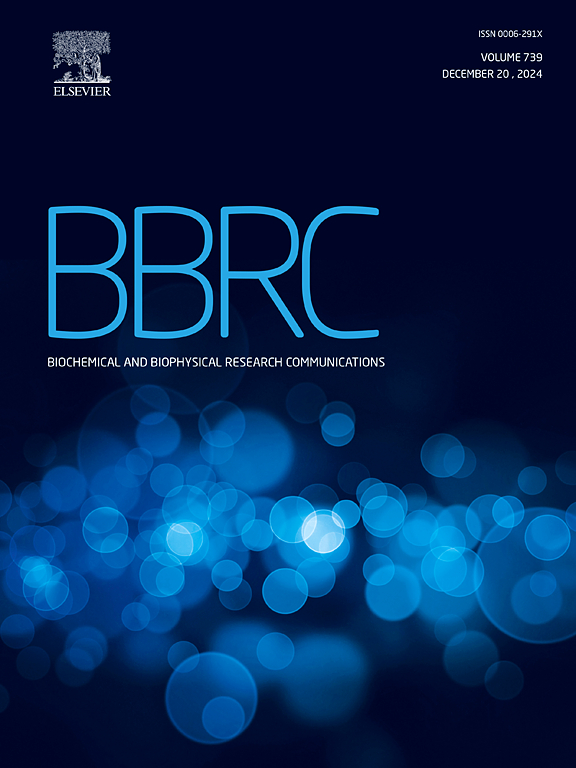在高脂肪饮食的小鼠中,低频率、轻度梯度的慢性间歇性缺氧仍可诱导肝纤维化
IF 2.5
3区 生物学
Q3 BIOCHEMISTRY & MOLECULAR BIOLOGY
Biochemical and biophysical research communications
Pub Date : 2025-04-01
DOI:10.1016/j.bbrc.2025.151744
引用次数: 0
摘要
当合并阻塞性睡眠呼吸暂停(OSA)时,代谢功能障碍相关脂肪变性肝病(MASLD)的纤维化可能会进展。使用动物模型的研究表明,与人类OSA类似的高频间歇性缺氧(IH)暴露会加速脂肪肝的肝纤维化。本研究强调,低频、轻度梯度间歇缺氧(IH)可加剧脂肪性肝病的纤维生成,即使没有显著升高肝损伤或胰岛素抵抗的标志物。使用高脂肪饮食(HFD)小鼠模型,我们发现暴露于室内空气(RA)的HFD小鼠与暴露于慢性间歇性缺氧(CIH)的HFD小鼠之间的常规肝脏检查(如ALT, AST)和胆固醇水平保持相当,但后者组的肝纤维化和氧化应激指标升高。这表明,即使是低频率、轻度梯度的IH也可以增加肝脏内的氧化应激和纤维化活性,主要是通过上调ICAM-1和骨桥蛋白(OPN)等特定标志物,这些标志物可能在cih诱导的脂肪肝肝脏炎症和纤维化中发挥作用。在结论。我们的研究进一步指出,这些与缺氧相关的变化并未显著恶化全身胰岛素抵抗,关注的是局部肝脏影响,而不是整体代谢破坏。这些发现强调了氧化应激和特定细胞因子在MASLD肝纤维化进展中的潜在作用,特别是当合并IH时。本文章由计算机程序翻译,如有差异,请以英文原文为准。

Low-frequency, mild-gradient chronic intermittent hypoxia still induces liver fibrogenesis in mice on a high-fat diet
The fibrogenesis of metabolic dysfunction-associated steatotic liver disease (MASLD) may progress when complicated by obstructive sleep apnea (OSA). Studies using animal models have shown that high-frequency intermittent hypoxia (IH) exposure, which resembles human OSA, accelerates liver fibrosis in fatty liver. This study highlights that low-frequency, mild-gradient intermittent hypoxia (IH) can exacerbate fibrogenesis in fatty liver disease, even without significantly raising markers of liver injury or insulin resistance. Using a mice model on a high-fat diet (HFD), we found that while routine liver tests (e.g., ALT, AST) and cholesterol levels remained comparable between HFD mice exposed to room air (RA) versus those exposed to chronic intermittent hypoxia (CIH), indicators of liver fibrosis and oxidative stress were elevated in the latter group. This suggests that even low-frequency, mild-gradient IH can increase oxidative stress and fibrotic activity within the liver, primarily through the upregulation of specific markers like ICAM-1 and osteopontin (OPN), which may play a role CIH-induced liver inflammation and fibrosis in fatty liver. In conclusion. Our study further notes that these hypoxia-related changes occurred without significantly worsening systemic insulin resistance, focusing attention on localized liver impacts rather than global metabolic disruptions. The findings underscore the potential role of oxidative stress and specific cytokines in the progression of liver fibrosis in MASLD, especially when complicated by conditions that introduce IH.
求助全文
通过发布文献求助,成功后即可免费获取论文全文。
去求助
来源期刊
CiteScore
6.10
自引率
0.00%
发文量
1400
审稿时长
14 days
期刊介绍:
Biochemical and Biophysical Research Communications is the premier international journal devoted to the very rapid dissemination of timely and significant experimental results in diverse fields of biological research. The development of the "Breakthroughs and Views" section brings the minireview format to the journal, and issues often contain collections of special interest manuscripts. BBRC is published weekly (52 issues/year).Research Areas now include: Biochemistry; biophysics; cell biology; developmental biology; immunology
; molecular biology; neurobiology; plant biology and proteomics

 求助内容:
求助内容: 应助结果提醒方式:
应助结果提醒方式:


